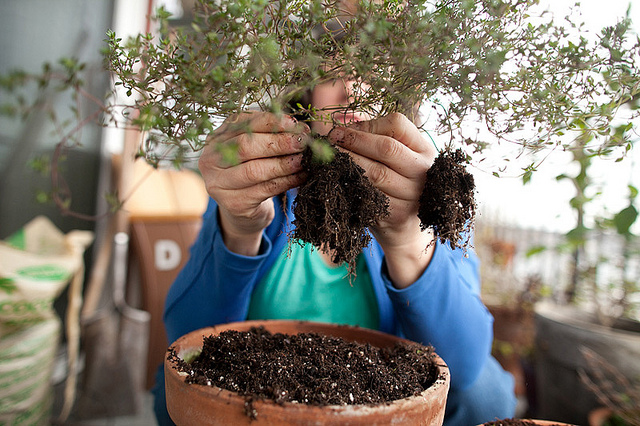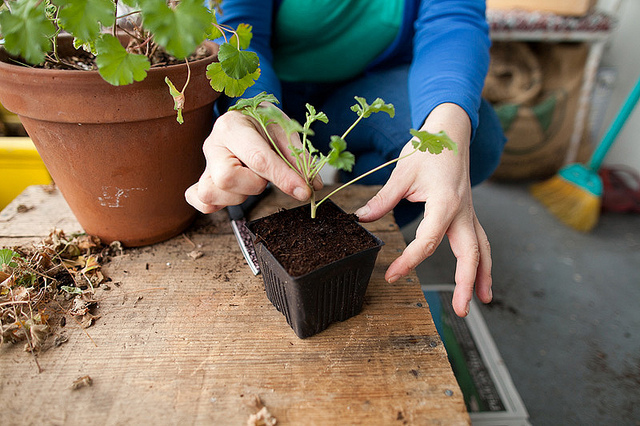How To :: Propagate Herbs
Last summer I met up with my friend Sarah, a farmer. Sarah has been farming for years and she's an absolute pro, so I asked her to meet me out at a new space to help me devise the perfect garden plan. (She's a genius that way – indispensible knowledge.) We met up and walked to the garden. On the way, she spotted a old, prolific fig tree and stopped in her tracks. "Oh – I need that," she exclaimed, and simultaneously reached into her back pocket as she crossed the street. With at quick snip, she cut a couple inches length from the fig plant, looked at me, and whispered, "You want one?"
 The practice of growing a plant from a small clipping is called propagation, but I had no idea you could grow a fig tree from a mere four inches of branch. Propagating a plant from a cutting or root division is one of the coolest parts of gardening. Propagating plants, quite simply, extends a plant's reproduction beyond the usual blooming and seeding. There are two methods we'll cover today: splitting the roots of a parent plant, called root division, and taking a cutting. (Grafting is also considered a form of propagation, but requires a bit more work.)
The practice of growing a plant from a small clipping is called propagation, but I had no idea you could grow a fig tree from a mere four inches of branch. Propagating a plant from a cutting or root division is one of the coolest parts of gardening. Propagating plants, quite simply, extends a plant's reproduction beyond the usual blooming and seeding. There are two methods we'll cover today: splitting the roots of a parent plant, called root division, and taking a cutting. (Grafting is also considered a form of propagation, but requires a bit more work.)
Root Division: Split One Plant Into Two Many herbs and plants can be divided by simply splitting up their roots: Thyme, Oregano, Mint, Strawberries, Rhubarb, Chives, Tarragon, Lovage, and Marjoram are all perfect candidates. It's easy:
1. Dig up the plant and its entire root system as best you can in early spring or fall. Growth is slow during these seasons, which makes this treatment easier on the plant.
2. Work apart the roots and slice through them with a clean knife or your hands. (You can also trim the root balls with scissors.) Be sure that each division has both healthy roots and at least one small green shoot!
3. Repot into a large enough pot and water well. Be sure to keep it watered well until the plant catches on and begins to put out new growth. You don't want to add any additional stress to the plant from lack of water!
A note for apartment gardeners: if you already have perennial herb pots going, it may be time for you to split them and separate the division into two pots. Every three years or so, perennial herbs do well with some dividing. Add some compost to the new potting mix and repot in a same-size or larger container. If you don't need more of the same herb, divide them anyway and repot as gifts for friends or neighbors.
Taking a Cutting: Cloning Your Plants Some plants root out from the stem, making them excellent candidates for cuttings. Examples include Figs -- like the one my friend Sarah clipped -- Lavender, Lemon Balm, Mint, Scented Geraniums, Tarragon, Sage, Lemon Verbena, and Oregano. (Yes, many plants can be propagated in both ways -- use the one most convenient for you.)
As a general rule of thumb, take a cutting from new plant growth. This is best done in late spring or early summer -- cuttings prosper in warm conditions. This also allows enough time for the cutting to put on some new growth without the stress and cold of winter.
1. On some plants, new growth comes in the form of a side shoot; in others it grows from the top of the plant's branches. Choose the newest growth and cut about a five inch length just below a set of leaves.
2. Remove the lowest leaves from the cutting, as well as any buds or blossoms on the stem. (If left, these will take energy away from the plant by producing seed.)
3. Place the cutting directly into a small pot of potting soil (leave it unfertilized for now), being sure to bury the lowest leaf node (the node is the area below the lowest leaves that you just removed) and water well. This leaf node is where the bulk of the plant's hormones are located, and they will aid in root development. Keep the cutting watered until the plant begins to put on new growth.
 You will know it's ready when the cutting does not pull out of the soil with a gentle tug, indicating the new growth is sufficient for transplanting to a bigger pot. This generally takes from four to six weeks.
You will know it's ready when the cutting does not pull out of the soil with a gentle tug, indicating the new growth is sufficient for transplanting to a bigger pot. This generally takes from four to six weeks.
There are many, many edible plants that you can propagate easily (including tomatoes!), so share in the comments if you have some great tips! And if you're interested in learning more about herbs, check out this upcoming class on Growing Herbs in Containers from Swanson's Nursery in Ballard, Seattle.
Photos by Della Chen






